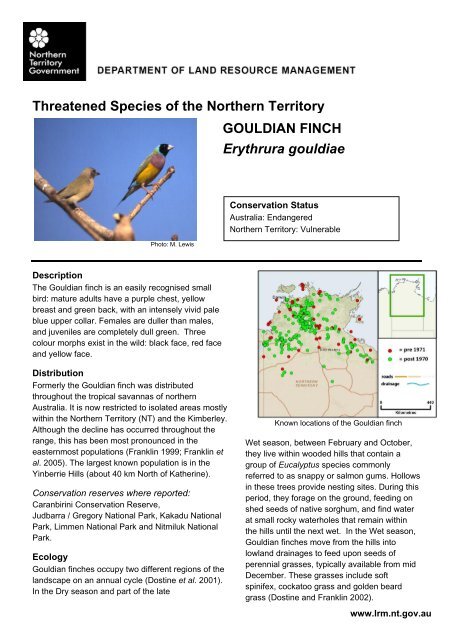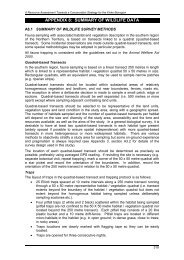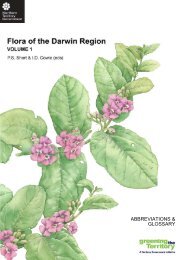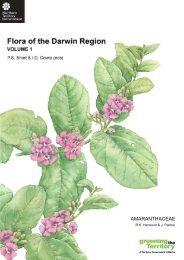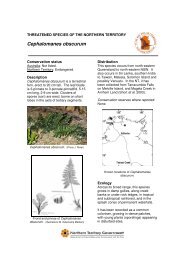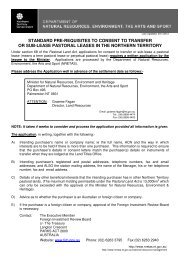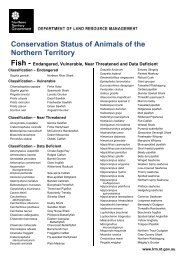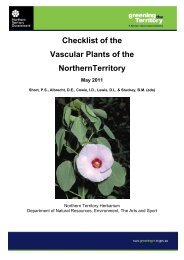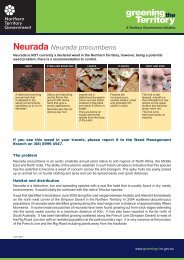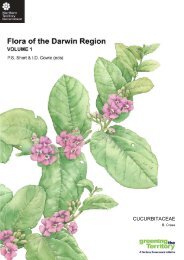GOULDIAN FINCH Erythrura gouldiae - Department of Land ...
GOULDIAN FINCH Erythrura gouldiae - Department of Land ...
GOULDIAN FINCH Erythrura gouldiae - Department of Land ...
You also want an ePaper? Increase the reach of your titles
YUMPU automatically turns print PDFs into web optimized ePapers that Google loves.
Threatened Species <strong>of</strong> the Northern Territory<br />
Photo: M. Lewis<br />
Description<br />
The Gouldian finch is an easily recognised small<br />
bird: mature adults have a purple chest, yellow<br />
breast and green back, with an intensely vivid pale<br />
blue upper collar. Females are duller than males,<br />
and juveniles are completely dull green. Three<br />
colour morphs exist in the wild: black face, red face<br />
and yellow face.<br />
Distribution<br />
Formerly the Gouldian finch was distributed<br />
throughout the tropical savannas <strong>of</strong> northern<br />
Australia. It is now restricted to isolated areas mostly<br />
within the Northern Territory (NT) and the Kimberley.<br />
Although the decline has occurred throughout the<br />
range, this has been most pronounced in the<br />
easternmost populations (Franklin 1999; Franklin et<br />
al. 2005). The largest known population is in the<br />
Yinberrie Hills (about 40 km North <strong>of</strong> Katherine).<br />
Conservation reserves where reported:<br />
Caranbirini Conservation Reserve,<br />
Judbarra / Gregory National Park, Kakadu National<br />
Park, Limmen National Park and Nitmiluk National<br />
Park.<br />
Ecology<br />
Gouldian finches occupy two different regions <strong>of</strong> the<br />
landscape on an annual cycle (Dostine et al. 2001).<br />
In the Dry season and part <strong>of</strong> the late<br />
<strong>GOULDIAN</strong> <strong>FINCH</strong><br />
<strong>Erythrura</strong> <strong>gouldiae</strong><br />
Conservation Status<br />
Australia: Endangered<br />
Northern Territory: Vulnerable<br />
Known locations <strong>of</strong> the Gouldian finch<br />
Wet season, between February and October,<br />
they live within wooded hills that contain a<br />
group <strong>of</strong> Eucalyptus species commonly<br />
referred to as snappy or salmon gums. Hollows<br />
in these trees provide nesting sites. During this<br />
period, they forage on the ground, feeding on<br />
shed seeds <strong>of</strong> native sorghum, and find water<br />
at small rocky waterholes that remain within<br />
the hills until the next wet. In the Wet season,<br />
Gouldian finches move from the hills into<br />
lowland drainages to feed upon seeds <strong>of</strong><br />
perennial grasses, typically available from mid<br />
December. These grasses include s<strong>of</strong>t<br />
spinifex, cockatoo grass and golden beard<br />
grass (Dostine and Franklin 2002).<br />
www.lrm.nt.gov.au
Clutch size averages around five and fledging rate is<br />
about one to two young per pair (Tidemann et al.<br />
1999). Depending on the season, pairs may raise<br />
several clutches per year. Annual survivorship is<br />
very low, with very few recoveries <strong>of</strong> banded birds<br />
from one year to the next (Woinarski and Tidemann<br />
1992).<br />
Stand <strong>of</strong> Eucalyptus tintinnans in the Yinberrie Hills north<br />
<strong>of</strong> Katherine (NT) used as a breeding site<br />
(Photo: M. Lewis)<br />
Conservation assessment<br />
There is evidence <strong>of</strong> range contraction and<br />
anecdotal and quantitative evidence <strong>of</strong> past<br />
population decline for the Gouldian finch. Data from<br />
the returns <strong>of</strong> licensed finch trappers operating in the<br />
Kimberley region <strong>of</strong> Western Australia suggested a<br />
rapid decline throughout the 1970s, leading to<br />
cessation <strong>of</strong> the legal trapping industry (Franklin et<br />
al. 1999).<br />
Gouldian finches are monitored at three sites in the<br />
Territory (Yinberrie Hills, Newry Station and Limmen<br />
National Park) at intervals <strong>of</strong> one to few years<br />
(including in 2009 and 2010). An internal report on<br />
the monitoring over the period<br />
1996-2004 indicated relative stability at Yinberrie<br />
Hills (Price et al. ms.), and subsequent results at all<br />
sites support this.<br />
There has been a large series <strong>of</strong> records <strong>of</strong> Gouldian<br />
finches in “new” locations across the Top End over<br />
the last few years, most notably including frequent<br />
records <strong>of</strong> hundreds near Maningrida, Mary River,<br />
and the Gregory – Victoria River District (mostly<br />
unpublished records, reported on NT Birds email<br />
list). The widespread nature <strong>of</strong> these records, and<br />
the large areas <strong>of</strong> similar but less accessible habitat,<br />
2<br />
leads to the conclusion that the NT<br />
population has stabilised (perhaps is<br />
increasing).<br />
The absolute size <strong>of</strong> the adult Gouldian<br />
finch population in the NT is difficult to<br />
determine, but is probably more than the D1<br />
threshold <strong>of</strong> 1 000. However, the unusual<br />
life history <strong>of</strong> the species results in the<br />
effective population size being smaller than<br />
the absolute population size. In particular:<br />
(1) the sex ratio <strong>of</strong> adults is strongly biased<br />
towards males, and (2) there may be<br />
strikingly low levels <strong>of</strong> genetic compatibility<br />
between different colour morphs, to the<br />
extent that “cross-breeding” may lead to<br />
very high rates <strong>of</strong> <strong>of</strong>fspring failure (40-80<br />
per cent <strong>of</strong> <strong>of</strong>fspring dead within three<br />
months in captive experiments: Pryke and<br />
Griffith 2009), suggesting a high degree <strong>of</strong><br />
instability in mixed and isolated populations.<br />
The Gouldian finch is considered<br />
Vulnerable in the NT (under criterion D1)<br />
due to:<br />
i. the effective population size estimated<br />
to number
2005). Recent research in the Kimberley indicates<br />
that the availability <strong>of</strong> breeding hollows may be more<br />
limited, and limiting, than previously thought, and<br />
may be significantly reduced by the frequent fire now<br />
characteristic <strong>of</strong> much <strong>of</strong> the Gouldian finch’s range<br />
(Brazill-Boast et al. 2010). There is also new<br />
evidence from the Kimberley that the impact <strong>of</strong><br />
pastoralism and fire on food resources may be very<br />
substantial (S. Legge, Australian Wildlife<br />
Conservancy, unpubl.).<br />
Conservation objectives and management<br />
There is a national recovery plan for this species<br />
(O’Malley 2006).<br />
Management priorities are to:<br />
ii. maintain long-term population monitoring via<br />
waterhole counts in the late Dry season in<br />
selected sites across the species’ range;<br />
iii. improve current burning practises through<br />
reduction <strong>of</strong> the extent <strong>of</strong> late Dry season fires<br />
and with special focus on trying to protect the<br />
Wet season feeding grounds; and<br />
iv. improve communication for on-ground<br />
management across different landholder groups<br />
on the threatening processes affecting Gouldian<br />
finch habitat, including fire management, grazing<br />
management and feral herbivore control.<br />
Compiled by<br />
Carol Palmer<br />
John Woinarski<br />
Simon Ward<br />
[updated December 2012]<br />
References<br />
Bell, P.J. (1996). Survey <strong>of</strong> the nasal mite fauna (Rhinonyssidae<br />
and Kytoditidae) <strong>of</strong> the Gouldian Finch, <strong>Erythrura</strong> <strong>gouldiae</strong>,<br />
and some co-occurring birds in the Northern Territory.<br />
Wildlife Research 23, 675-686.<br />
Brazill-Boast, J., Pryke, S.R., and Griffith, S.C. (2010). Nest-site<br />
utilisation and niche overlap in two sympatric, cavity-nesting<br />
finches. Emu 110, 170-177.<br />
Dostine, P.L., and Franklin, D.C. (2002). A comparison <strong>of</strong> the<br />
diet <strong>of</strong> three finch species in the Yinberrie Hills area,<br />
Northern Territory. Emu 102, 159-164.<br />
Dostine, P.L., Johnson, G.C., Franklin, D.C., Zhang, Y., and<br />
Hempel, C. (2001). Seasonal use <strong>of</strong> savanna landscapes<br />
3<br />
by the Gouldian finch, <strong>Erythrura</strong> <strong>gouldiae</strong>, in the<br />
Yinberrie Hills area,<br />
Northern Territory. Wildlife Research 28, 445-458.<br />
Franklin, D.C. (1999). Evidence <strong>of</strong> disarray amongst<br />
granivorous bird assemblages in the savannas<br />
<strong>of</strong> northern Australia: a region <strong>of</strong> sparse human<br />
settlement. Biological Conservation 90, 53-68.<br />
Franklin, D.C., Whitehead, P.J., Pardon, G.,<br />
Matthews, J., McMahon, P., and McIntyre, D.<br />
(2005). Geographic patterns and correlates <strong>of</strong><br />
the decline <strong>of</strong> granivorous birds in northern<br />
Australia. Wildlife Research 32, 399-408.<br />
Garnett, S.T., and Crowley, G.M. (1994). Wet-season<br />
feeding by four species <strong>of</strong> granivorous birds in<br />
the Northern Territory. Australian Bird-watcher<br />
15, 306-309.<br />
Garnett, S.T., and Crowley, G.M. (2000). The Action<br />
Plan for Australian Birds, 2000. (Environment<br />
Australia, Canberra.)<br />
Garnett, S.T., Szabo, J.K., and Dutson, G. (2011).<br />
The action plan for Australian Birds 2010.<br />
(CSIRO Publishing/Birds Australia, Melbourne.)<br />
O’Malley, C. (2006). National Recovery Plan for the<br />
Gouldian Finch (<strong>Erythrura</strong> <strong>gouldiae</strong>). WWF-<br />
Australia, Sydney and Parks and Wildlife NT,<br />
<strong>Department</strong> <strong>of</strong> Natural Resources, Environment<br />
and the Arts, NT Government, Palmerston.<br />
Pryke, S.R. and Griffiths, S.C. (2009). Postzygotic<br />
genetic incompatibility between sympatric color<br />
morphs. Evolution 63, 793-798.<br />
Tidemann, S.C. (1990). The relationship between<br />
finches and pastoral practices in northern<br />
Australia. In: Granivorous Birds and Agriculture.<br />
(eds J. Pinowski and J.D. Summers-Smith) pp.<br />
305-315. (PWPN – Polish Scientific Publishers,<br />
Warsaw.)<br />
Tidemann, S.C., Lawson, C., Elvish, R., Boyden, J.,<br />
and Elvish, J. (1999). Breeding biology <strong>of</strong> the<br />
gouldian finch <strong>Erythrura</strong> <strong>gouldiae</strong>, an<br />
endangered finch <strong>of</strong> northern Australia. Emu 99,<br />
191-199.<br />
Tidemann, S.C., McOrist, S., Woinarski, J.C.Z., and<br />
Freeland, W.J. (1992). Parasitism <strong>of</strong> wild<br />
Gouldian Finches <strong>Erythrura</strong> <strong>gouldiae</strong> by the air<br />
sac mite Sternostoma tracheacolum. Journal <strong>of</strong><br />
Wildlife Diseases 20, 80-84.<br />
Woinarski, J.C.Z., and Tidemann, S.C. (1992).<br />
Survivorship and some population parameters<br />
for the endangered Gouldian Finch <strong>Erythrura</strong><br />
<strong>gouldiae</strong> and two other finch species at two sites<br />
in tropical northern Australia. Emu 92, 33-38.<br />
Woinarski, J.C.Z., Williams, R.J., Price, O., and<br />
Rankmore, B. (2005). <strong>Land</strong>scapes without<br />
boundaries: wildlife and their environments in<br />
northern Australia. Wildlife Research 32, 377-<br />
388.


